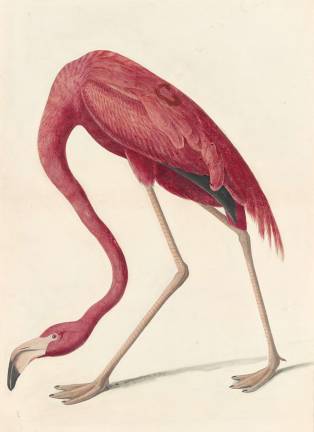N-YHS and The Arsenal Gallery Have Gone Bird Crazy


New York City is bird country, in case you haven't noticed. Some 350 wild species, nearly a third of all bird species on the North American continent, make their homes here or visit each year. Recent sightings of snowy owls (not Hedwig, alas) on Governors Island and the shores of Brooklyn and Queens are cases in point.
But the city has become even more bird friendly with the opening of two exhibits devoted to avian paintings — one by legendary watercolorist John James Audubon (1785-1851), at the New-York Historical Society, and the other by New York wildlife artist Alan Messer, at The Arsenal in Central Park, headquarters of the New York City Department of Parks.
The show at the Historical Society is the third and final installment of the magnificent exhibition of watercolors made for Audubon's opus, “The Birds of America” (1827-1838), a mammoth encyclopedia that sought to visually document each and every bird species in North America. Audubon was not the first to make the attempt; ornithologist Alexander Wilson set the example. But Audubon's book, a double elephant (referring to the size of the paper) folio with 435 life-size prints made from copper plates engraved by Robert Havell Jr., became the gold standard.
The Historical Society boasts the largest collection of Auduboniana in the world. A special feather in its cap is ownership of these 435 original watercolors, representing over 1,000 birds and 500 species. More than 135 of those are included in the current show, with 180 species on parade, along with a chirpy audio guide with birdcalls and songs, courtesy of the Cornell Lab of Ornithology. In the gallery, iPads afford a close-up view of Havell's plates, based on the watercolors, while a video screen projects images of the paintings and scenes from the natural environment, underscoring Audubon's extensive forays into the field to observe “the feathered race” (his term).
Dr. Roberta Olson, the Historical Society's curator of drawings, recently led a spirited tour of the show, declaring Audubon “America's Leonardo,” since, like his forebear, he infused his art with scientific precision and rigor. “Naturalists in the 19th century were the intelligentsia,” she explained. Both a naturalist and an artist, Audubon hunted and harvested thousands of birds for his painted catalog. His settings evoked the natural habitats of the various species—an “embedding” of his subjects in the interests of verisimilitude.
But the operative word here is “cinematic,” a word frequently invoked by the curator to describe the dramatic action on the walls. Birds are flying, diving, swimming, eating, walking, preening, yawning, honking and generally engaging with one another in a fast and furious way. “The birds are alive and engage us,” Olson said exuberantly. Dismissing any notion that these were static images, she emphasized throughout the tour that Audubon “was always involved with behavior” and pointed to a red-bellied woodpecker's long, sticky tongue reaching out for food in a woodpecker group portrait (1822; 1836-37) to make her case.
This artist's genius was boundless. The birds in his compositions are all life-size, a historic feat. Feathers are palpable, and some, like those of the “Great Gray Owl” (c. 1834-36), have a velvety sheen. Audubon even “invented collage—not Braque or Picasso,” the curator claimed. Indeed, “Green Heron” (c. 1821-22) radically boasts a cutout image of the “Dad” bird, with an overlapping leaf creating a 3-D effect. This kind of layering was unknown at the time.
But “American Flamingo” (1838) in shocking pink is the show's glorious signature image. During our visit, the Society's double elephant folio was opened to this brilliantly colored bird, creatively positioned to fit the page. One of four flamingo species native to the Americas, the creature appears to be in the act of feeding and, as Olson noted of the animated portrait on the wall, it is “looking at us and walking off the page.” Audubon had observed flamingos in the Florida Keys and worked from specimens sent to him from Cuba, two preserved in spirits.
Pro tip: A visit to N-YHS to see the Audubons should be combined with a walk through Central Park to The Arsenal Gallery to see the avian paintings of artist-ornithologist Alan Messer. A New Yorker by way of Oregon, Messer seeks inspiration in the park's Ramble, the marshes of Jamaica Bay, the islands in the Harbor, and the city's abundant green spaces. The 30 beautiful works in “Conserving Our City of Nature,” presented by NYC Audubon and on view until April 23, include delicate oil and watercolor renderings of myriad species. Messer will deliver a talk about his art at The Arsenal Gallery on April 8 at 6pm (email artandantiquities@parks.nyc.gov to RSVP).
Get ready.